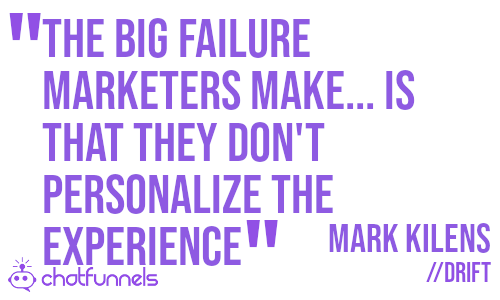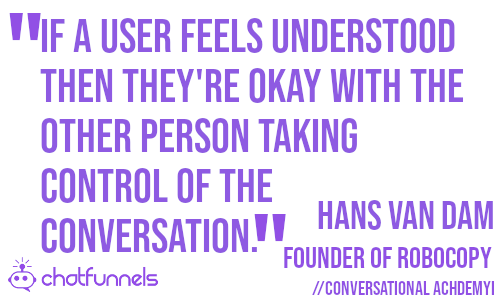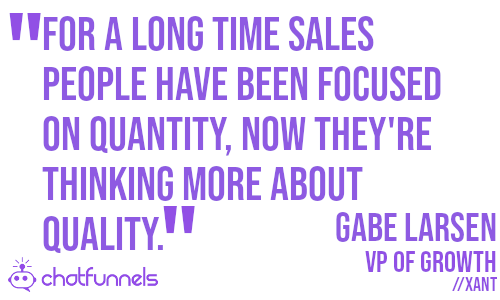The Best Digital Conversations Podcasts of 2019

Reading Time: 8 minutes
Overview: This episode includes the highlights of our 2019 podcasts. They discuess a variety of topics from retargeting bots to using an omni-channel approach to improving your funnel. Featuring Mark Kilens, Hans Van Dam, Ish Jindal, Gabe Larsen and Tom Jenkins.
Guests : Mark Kilens- Mark Kilens is VP of Content and Community at Drift where he leads the blogging, editorial, social, Drift Insider, and HYPERGROWTH teams.
Hans Van Dam– Hans van Dam is co-founder of Robocopy and the Conversational Academy. His goal is to develop and promote the role of the conversation designer. He develops curriculum for the Conversational Academy, lectures at multiple universities, and speaks often at conferences around the world.
Ish Jindal- Building Tars to help businesses boost their PPC conversion rates through Conversational Landing Pages.
Gabe Larsen- Gabe Larsen—evangelist of the Provo-based, aspiring unicorn InsideSales.com; vice president of marketing; host of the popular Sales Secrets podcast; and president of the Utah Chapter of the American Association of Inside Sales Professionals (AAISP)
Tom Jenkins- I design and implement sales and marketing strategies for growing and socially focused organizations. At present, I’m happily leading the Marketing Team at CloudTask.
Reference:
Mark: So I think the thing that people need to realize is. I’ll take a step back. Conversational marketing is not Chat bot. It’s not live chat. Those are tools. Right, those are tools. Email is a tool. Yeah, for sure. It can be kind of a channel. It’s definitely more of a tool if you think.
Billy SMS is a tool. It’s a tool. The phone’s a tool.
Mark What conversational marketing is, it’s an overarching philosophy and strategy to start more conversations that will help your sales team connect with people faster and create a better customer experience which all are in service of driving more revenue. Right, or attaining net revenue. So when you ask about retargeting, there’s a blueprint that I know you folks have used that is super important to retargeting. because it’s a little bit more complicated. Right.
Because I get what you’re saying here. Visitors coming back to the Web site. And I want to serve up a different experience for sure. Maybe. So it all begins with what page are you trying to reach targets on and on? Who are you trying to engage with? For the second, third could be tough time. Does it matter where they’re coming from?
Or if they came on because it’s an occasion program? An e-mail nurture. Maybe they came from a paid ad that says, you know, maybe from social. Then you should ask yourself, why are they coming back to your Web site for the X amount of time? Whatever. Like that second visit or fifth visit? It might be. Yeah.

And why are they on that page and why do they want to maybe ask you a question or start a conversation with you and why do you want to have a conversation with them? So you can map those those things up to what, the who, the where, the why. You can then create really sophisticated targeting campaigns based off of what you know about that person.
Because I think the big failure marketers make today and it goes back to your conversion rates, optimization point. It goes back to not generating enough pipeliner revenue, even though your top of the phone looks healthy, is because they don’t take the time to slightly personalize the experience based off of who’s visit the website at that point. And I think that’s where retargeting comes into play.

Hans:Yeah. So, I mean, if you, what happens when you do the sample dialogue? Right. What that enables you to do is have much more empathy in a beginning because you start to understand your users so well. Maybe you’re on a landing page and you want people to download your paper. You go through to canvas and you start to understand your users. You look at, you know, the boosters, the barriers and the information meets that they might have.
And the person getting into character is going to play that out. Right. The bots will, you know, get to understand that better and better and better.
Here’s the thing. If you do as a user or as a human in general, if you feel understood, they’re okay with the other person taking control of the conversation. So if you feel like, hey, I really understand what’s happening in your mind, what your concern is and you sort of feel like I take you seriously. Then you’re OK.
You want to follow along. Usually these chat bots are bad because in that respect, there’s no empathy because what happens when you don’t feel understood? That’s when you start talking a lot. Right. And that’s when you’re giving me input. And it breaks. So what we do is we have more empathy in the beginning.
The user feels understood. And then we can pretty much have a very simple dialogue with very binary questions, very short and simple. They’re usually a bit longer than other people’s designs, but they work better because you’re OK and you have trust in the experience. So empathy in the beginning.
Then there’s like, you know, short, simple questions that are very binary that you’re happy to answer. And per prompt what we really what we look for or per note is, you know, don’t make it too long. So we have to one breath test. If it’s you know, if you can’t read out a prompt in one breath, then it’s too long.
Then we have what we called a Jenga technique, you know, like Jenga? That way you have to tower with all the little blocks, right. You have to take them out one by one. We do that with everything we write. So we look at the tower of meaning and that we take out the words without the tower of meaning collapsing and just go over your writing. You can pretty much take out 50 percent of the words of everything that you write.
So you can make it much shorter and much snappier. So once you have the structure of the conversation and you’ve really trimmed it down, now it’s time to apply certain conversation, design fundamentals. Every turn that you write for, you want to have an acknowledgement, you want to have a confirmation in there.
Sometimes implicit, sometimes explicit. And you want to end with a short question, pretty much a prompt to sort of let the other person know that’s their time to speak again. Right.
So once you have those fundamentals in place, that’s when you go sort of to your personality. Right? You want to make sure that the brand is represented, the boss personality that you’ve crafted is in there. So, you know, you have standard vocabulary that you do and don’t use.
And then the last step is really to apply more psychology.

Ish: Now chatbot as an interface or chat as an interface especially in the business context is very new.
Now websites have been around for 2 decades at this point of time, almost 2 decades right and there has been a lot of evolution in terms of to what websites or landing pages used to look like say back in 2000 to what they look like at this point of time.
The thing about chatbots is they have been around for a few years like 3 years, 3 or 4 years max. I remember when we started TARS and I used to do these outbound sales calls nobody used to get what a chatbot was so I can definitely say that it’s been around for 3 years as a buzz word or as a hype word. Now since the space is so new there is going to be a lot of evolution in terms of how we will create chatbots that actually convert.
They are not a lot of people in the world out there at this point in time who are thinking about how to make good conversation flows because at this point in time a marketers, someone is telling a marketer in a company to go ahead and start using a chatbot but nobody, people have not really started thinking about how to create good chatbots that will actually convert.
That’s totally fine but I think there will be a separate job profile per se in organizations which would essentially be about conversational designers or something on that front, whose job would be to create these good conversations. Just like you have these email marketers whose expertise lies in how they can write emails that actually get a good open rate and good click rate. Something similar would happen but for chatbot conversations.
Just like yourself we have been helping our customers as well, and we have been trying to make them understand that chatbot is not really a magic wand. It won’t happen that you just start using a chatbot and your conversion rate will shoot up.
You have to make good conversation flows people think i’m going to pay for a chatbot and my conversion rate is going to shoot up in a week or so. This is not going to happen. You have to really make an effort to make this thing work as well and we want to help you with this but yes, you have to make an effort.

Gabe: Number one is for a long time, sales people have been focused on quantity.
Now they’re thinking more about quality. And I’d probably, you know, we could dive into some other things. But I want to spend just a second on here because this, you know, idea of just unwanted, untargeted, you know, unabashed spamming type of outreach is starting to slow down.
It’s companies start to use words like personalization as they start to use words like prioritization, thinking more about, you know, what they should say rather than just kind of throwing things out the side.
Probably say that that’s number one or one big trend. The second is that we’ll get into this. It’s this multi-channel or omni channel approach to engagement. It’s just as you look out in the market.
Companies have been dedicated to tech tools and communication methods that they’re comfortable with. And that’s obviously led by the phone, voicemail and e-mail. That world is just it’s not dying. It’s just changing. You know, a lot of people don’t want to answer the phone. But truthfully, a lot of people don’t listen to voicemail. Truthfully, a lot of people don’t check their LinkedIn.
What we’re finding is that the buyer needs to be engaged with where the buyer wants to be engaged with. Companies are finding that the hard way. They’ve got people who love the phone, they love e-mail, and they’re not getting the rates they want.
As soon as they start to change and more and find where the buyer is, they’re starting to have more success. So I’d say number two is probably on that omni channel approach. So those would be kind of two maybe interesting ones I think are out there.
Tom: Yeah. So social, clearly a big one now on Linked-In. That’s just, you know, I’m a bit Gary B. for you, I’m sure other people listening in on organic reach there you can get through Linked-In is crazy when you’re just building your personal brand and brand presence.
And I think when again, when you learn to do Linked-In right, then, you know, not just say it’s not a site, you call it social selling is not a sales tool, it’s an engagement. And then that was building tool. One of our trainers said that, is a way to start with me. Just think of Linked-In signing it.
Do you think the Facebook, Twitter and Instagram with your friends? Yeah. Bit more professional, of course. But, you know, you’re just being nice. Building relationships, educating, kind of having fun, adding value. Just forget about the sales side. Once you’ve got a relationship then you can, then. That relates that conversation.

Yeah, the initial relationship buildings K and you know, let’s not forget the phones, the phones. They are king of sales. So, yeah, let’s not forget the phone. The phone is still king of sales, so to speak. It’s where we generate most of our results. We love chat, chat is brilliant.
I always try to use them all in combination. So using Linked-In. In combination with chat, in combination with the phone, in combination with email. If you got the cadences right, we’ll touch points for each. Every channel is just going to snowball and benefit the other one.
